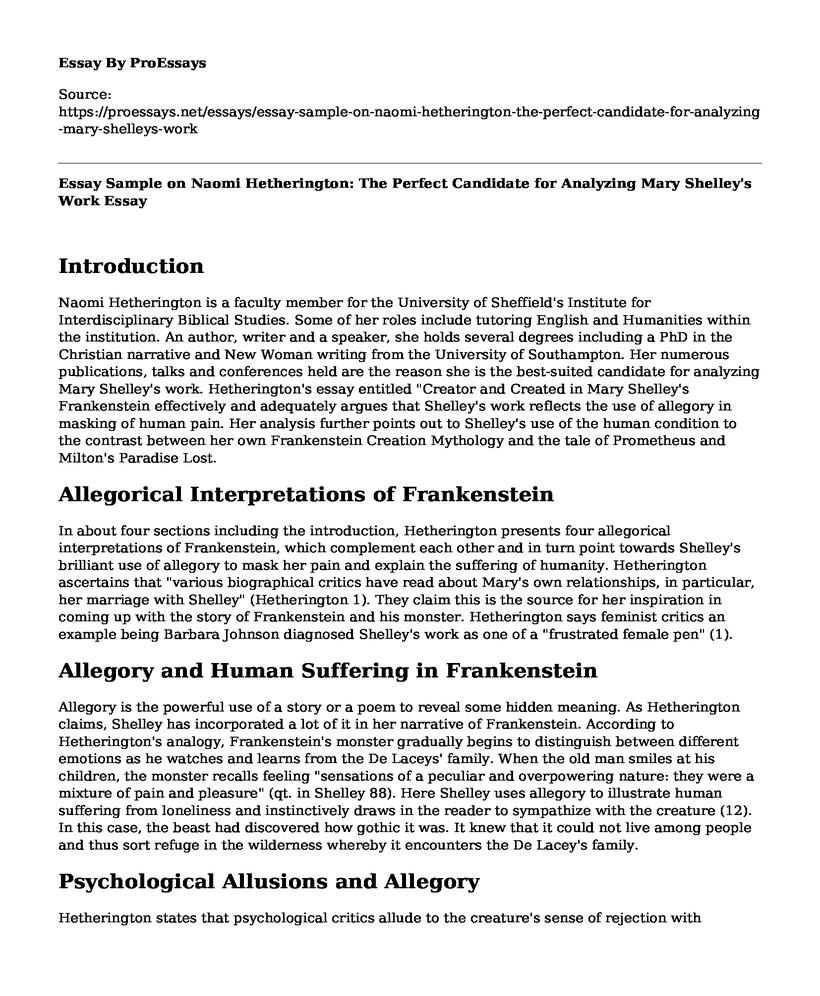Introduction
Naomi Hetherington is a faculty member for the University of Sheffield's Institute for Interdisciplinary Biblical Studies. Some of her roles include tutoring English and Humanities within the institution. An author, writer and a speaker, she holds several degrees including a PhD in the Christian narrative and New Woman writing from the University of Southampton. Her numerous publications, talks and conferences held are the reason she is the best-suited candidate for analyzing Mary Shelley's work. Hetherington's essay entitled "Creator and Created in Mary Shelley's Frankenstein effectively and adequately argues that Shelley's work reflects the use of allegory in masking of human pain. Her analysis further points out to Shelley's use of the human condition to the contrast between her own Frankenstein Creation Mythology and the tale of Prometheus and Milton's Paradise Lost.
Allegorical Interpretations of Frankenstein
In about four sections including the introduction, Hetherington presents four allegorical interpretations of Frankenstein, which complement each other and in turn point towards Shelley's brilliant use of allegory to mask her pain and explain the suffering of humanity. Hetherington ascertains that "various biographical critics have read about Mary's own relationships, in particular, her marriage with Shelley" (Hetherington 1). They claim this is the source for her inspiration in coming up with the story of Frankenstein and his monster. Hetherington says feminist critics an example being Barbara Johnson diagnosed Shelley's work as one of a "frustrated female pen" (1).
Allegory and Human Suffering in Frankenstein
Allegory is the powerful use of a story or a poem to reveal some hidden meaning. As Hetherington claims, Shelley has incorporated a lot of it in her narrative of Frankenstein. According to Hetherington's analogy, Frankenstein's monster gradually begins to distinguish between different emotions as he watches and learns from the De Laceys' family. When the old man smiles at his children, the monster recalls feeling "sensations of a peculiar and overpowering nature: they were a mixture of pain and pleasure" (qt. in Shelley 88). Here Shelley uses allegory to illustrate human suffering from loneliness and instinctively draws in the reader to sympathize with the creature (12). In this case, the beast had discovered how gothic it was. It knew that it could not live among people and thus sort refuge in the wilderness whereby it encounters the De Lacey's family.
Psychological Allusions and Allegory
Hetherington states that psychological critics allude to the creature's sense of rejection with Shelley's own unsatisfactory childhood experiences. Mary's mother dies of septicaemia when she is eleven days old. Her father becomes emotionally withdrawn, and when Mary reaches the age of four, he re-marries. The woman he re-marries has two young children of her own (16). The 1818 text as according to Hetherington is equally a proleptic of the grief young Mary is to bear later on.
The allegory here is quite alluring as Frankenstein seems to anticipate the death of his younger brother. Similarly, Shelley's own son by the name William dies. The human pain that Mary experienced when her husband Shelley drowns is reminiscent of the pain the creature feels when he sees his mate dead on Frankenstein's dissecting table. From this point, her journal entries are quite heart-rending for they depict her severance from human affection. In scribbling the creature's final words, "I never shall be loved more-never o never more shall I love...I am a wreck--by what do the fragments cling together" (qt. in Shelley 65). She Mary opens up of the pain she is feeling like the loss she has faced being vast and unfathomable.
Allegory as a Mask for Human Pain
Similarly, the essay La Belle Assemblee agrees with Hetherington's analysis of the use of allegory to mask human pain. The essay talks about the great suffering that Frankenstein feels when Elizabeth dies. "Great God! Why did I not then expire?" (Assemblee 4). Besides, the Edinburg Magazine and Literary Miscellany effectively and adequately support the thesis statement. The article explores the pain Frankenstein feels when he discovers the monster is his brother's murderer. "The thought instantly strikes him, that this fiend, must have been the murderer of his brother, and he feels all the bitterness of despair" (Edinburg 3).
Conclusion
In conclusion, as Shelley shows in Frankenstein, human pain is an allegory in itself which can be unravelled when true feelings and emotions are unmasked. Shelley cleverly narrates her own childhood experiences, loss, moments of despair in a brilliant yet alluring story. Hetherington, the Assemblee, and Edinburg magazines each explore the in-depth message that Shelley attempts to appropriate. In a step by step analysis, the three articles analyze the validity of Shelley's use of allegory in masking human pain.
Works Cited
Hetherington, Naomi. "Creator and Created in Mary Shelley's Frankenstein." Keats Shelley Review, 1997, pp. 1-39.
"La Belle Assemblee, or Bell's Court and Fashionable Magazine." La Belle Assemblee, or Bell's Court and Fashionable Magazine, 17 Mar. 1818, pp. 139-142.
Wang, Orrin N.C. "The Edinburgh Magazine and Literary Miscellany; A New Series of 'The Scots Magazine.'" The Edinburgh Magazine and Literary Miscellany; A New Series of "The Scots Magazine", 2 Mar. 1818, pp. 249-253.
Cite this page
Essay Sample on Naomi Hetherington: The Perfect Candidate for Analyzing Mary Shelley's Work. (2023, Mar 23). Retrieved from https://proessays.net/essays/essay-sample-on-naomi-hetherington-the-perfect-candidate-for-analyzing-mary-shelleys-work
If you are the original author of this essay and no longer wish to have it published on the ProEssays website, please click below to request its removal:
- Comparative Essay Example: Alchemist vs. Great Expectations
- Race in to Kill a Mockingbird Essay
- Literary Realism and Distortion in Great Expectations by Charles Dickens Essay
- Essay Example on the Significance of the Setting in Richard III
- Paper Example on Aldous Huxley's 'Brave New World': Tech's Pros & Cons
- Paper Example on Antigone: Civil Disobedience and Conflict Over Family Rights
- Streetcar Named Desire by Tennessee Williams - Essay Sample







